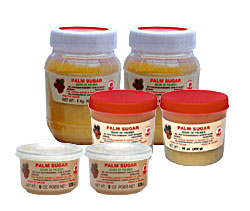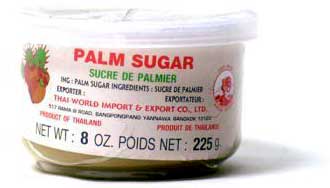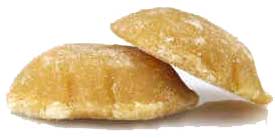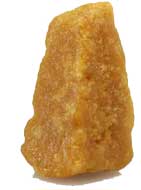 Subscribe to my feed for ingredients
Subscribe to my feed for ingredients  Add to My Yahoo
Add to My Yahoo 
© Copyright 1995-2023, Clay Irving <clay@panix.com>, Manhattan Beach, CA USA
 Subscribe to my feed for ingredients
Subscribe to my feed for ingredients  Add to My Yahoo
Add to My Yahoo
Palm Sugar Characteristics
Palm sugar, also known as jaggery or gur in India1, nam som paep or nam tann peep in Thai, gula melaka in Malaysia gula bail in Bali, or gula jawa in Indonesia, is made from the sap from the palmyra, or sugar palm. The trunk of the tree is tapped and drained of its sap for several months before the sap is boiled down to a syrup. The syrup is poured into molds, directly into containers, or further processed into hard crystiline chunks. Because it is not highly processed like brown sugar, the color, consistency, flavor and level of sweetness can vary from batch to batch, even within the same brand. The sugar ranges from almost white to pale honey-gold to deep, dark brown in colour with variable consistency.
| There is no identical Western counterpart, but there are substitutes which give a reasonable flavour likeness. If the recipe calls for a quantity of palm sugar, use a mixture of equal parts maple syrup and either soft brown sugar or black sugar (depending whether you desire a lighter or darker-coloured result)
Sugar palm trees are very tall and beautiful. They grow in most parts of Thailand. If the palm sap is not used by the end of the day, it will start to ferment and turn into palm sugar wine. In Thailand evening, some farmers may sit under the palm trees and drink their homemade palm sugar wine and get drunk. Later they ride their buffaloes home so they don't have to worry about a 'drink and drive'. In Thai, the word nam tann for sugar literally means palm juice. The word 'peep' is the pail that palm sugar comes in. |
 |
Varieties
 |
 |
 |
 |